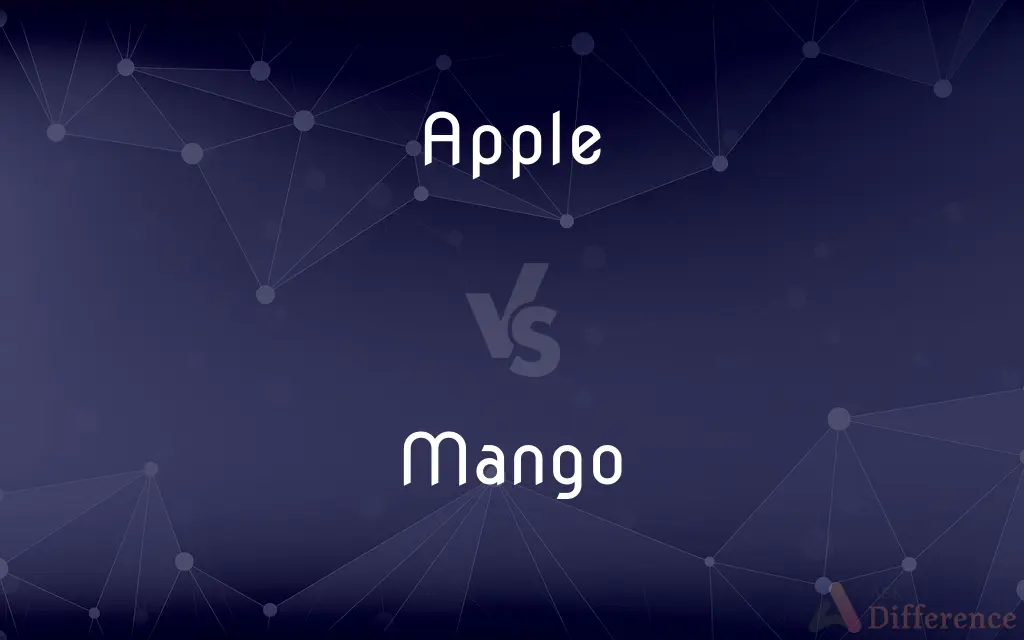Apple vs. Mango — What's the Difference?
By Fiza Rafique & Maham Liaqat — Updated on April 4, 2024
Apples are crunchy, mildly sweet fruits known for their wide variety and cool-climate growth, while mangos are tropical fruits celebrated for their juicy, sweet, and sometimes tangy flavor.

Difference Between Apple and Mango
Table of Contents
ADVERTISEMENT
Key Differences
Apples are grown in temperate regions and are known for their crisp texture and a wide range of flavors, from tart to sweet. They are versatile in culinary uses, from fresh eating to baking. Whereas mangos, originating from tropical climates, offer a rich, sweet, and sometimes tangy flavor, making them popular in a variety of dishes, from salads to desserts.
The nutritional profiles of apples and mangos differ slightly. Apples are a good source of fiber and Vitamin C, and they are often praised for their health benefits, including heart health and weight management. On the other hand, mangos are rich in vitamins A and C, antioxidants, and they have a higher sugar content, which contributes to their sweet taste.
In terms of cultivation, apples require a chilling period to bear fruit, making them suitable for growth in cooler climates. They are harvested once a year. Mangos thrive in warm, tropical climates and do not require a chilling period. Depending on the variety, mangos can have several harvests within a year.
Culturally, apples have a significant presence in Western mythology and traditions, symbolizing knowledge, beauty, and temptation. They are integral to various holidays and customs. Conversely, mangos hold a sacred place in many Asian cultures, symbolizing love and fertility. They are celebrated in numerous festivals and rituals.
Regarding their global distribution, apples are widely cultivated across the United States, Europe, and China, making them accessible year-round in many parts of the world. Mangos, while also globally available, are primarily grown in India, Thailand, and Mexico, with their peak season varying by region.
ADVERTISEMENT
Comparison Chart
Origin
Temperate climates
Tropical climates
Taste
Ranges from tart to sweet
Sweet and sometimes tangy
Nutrition
High in fiber and Vitamin C
Rich in vitamins A and C, higher sugar content
Cultivation
Requires chilling period, annual harvest
No chilling required, possible multiple harvests
Cultural Significance
Symbolizes knowledge in Western cultures
Represents love and fertility in Asian cultures
Compare with Definitions
Apple
Culinary Uses.
Apples are used in everything from pies and cakes to salads and sauces.
Mango
Vitamin-Rich.
Mangos are a great source of vitamins A and C, supporting eye health and immunity.
Apple
Cultural Presence.
In mythology, the apple is often associated with knowledge and temptation.
Mango
Tropical Delight.
Mangos need warm, tropical climates to grow, making them a staple in these regions.
Apple
Versatile Flavors.
From the tart Granny Smith to the sweet Fuji, apples offer a wide range of tastes.
Mango
Symbol of Love.
In many cultures, mangos are a symbol of love and are used in festivals and rituals.
Apple
Temperate Fruit.
Apples thrive in cooler climates, requiring cold winters to produce fruit.
Mango
Rich and Sweet.
The unique flavor of mangos ranges from sweet to tangy, depending on the variety.
Apple
Nutritional Benefits.
Eating apples regularly can contribute to heart health and weight management.
Mango
Diverse Dishes.
Mangos are celebrated in cuisines worldwide, from chutneys to smoothies.
Apple
An apple is an edible fruit produced by an apple tree (Malus domestica). Apple trees are cultivated worldwide and are the most widely grown species in the genus Malus.
Mango
A mango is an edible stone fruit produced by the tropical tree Mangifera indica which is believed to have originated from the region between northwestern Myanmar, Bangladesh, and northeastern India. M. indica has been cultivated in South and Southeast Asia since ancient times resulting in two distinct types of modern mango cultivars: the "Indian type" and the "Southeast Asian type".
Apple
The round fruit of a tree of the rose family, which typically has thin green or red skin and crisp flesh.
Mango
A tropical evergreen tree (Mangifera indica) native to Asia, widely cultivated for its edible fruit.
Apple
The tree bearing apples, with hard pale timber that is used in carpentry and to smoke food.
Mango
The oval fruit of this tree, having a smooth rind, sweet juicy flesh, and a flat one-seeded stone, and eaten ripe or pickled when green.
Apple
A cultivated deciduous tree (Malus domestica or M. pumila) in the rose family, native to Eurasia and having alternate simple leaves and white or pink flowers.
Mango
Chiefly North Midland US A bell pepper, especially a green one.
Apple
The firm, edible, usually rounded fruit of this tree.
Mango
A tropical Asian fruit tree, Mangifera indica.
Apple
Any of several other plants, especially those with fruits suggestive of the apple, such as the crabapple or custard apple.
Mango
The fruit of the mango tree.
Apple
The fruit of any of these plants.
Mango
A pickled vegetable or fruit with a spicy stuffing; a vegetable or fruit which has been mangoed.
Apple
A common, round fruit produced by the tree Malus domestica, cultivated in temperate climates.
Mango
A green bell pepper suitable for pickling.
Apple
Any fruit or vegetable, or any other thing produced by a plant such as a gall or cone, especially if produced by a tree and similar to the fruit of Malus domestica; also (with qualifying words) used to form the names of specific fruits such as custard apple, rose apple, thorn apple etc.
Mango
A type of muskmelon, Cucumis melo.
Apple
The ball in baseball.
Mango
Any of various hummingbirds of the genus Anthracothorax.
Apple
(informal) When smiling, the round, fleshy part of the cheeks between the eyes and the corners of the mouth.
Mango
A yellow-orange color, like that of mango flesh.
Apple
The Adam's apple.
Mango
(uncommon) To stuff and pickle (a fruit).
Apple
(Christianity) The fruit of the Tree of Knowledge, eaten by Adam and Eve according to post-Biblical Christian tradition; the forbidden fruit.
Mango
The fruit of the mango tree. It is rather larger than an apple, and of an ovoid shape. Some varieties are fleshy and luscious, and others tough and tasting of turpentine. The green fruit is pickled for market.
Apple
A tree of the genus Malus, especially one cultivated for its edible fruit; the apple tree.
Mango
A green muskmelon stuffed and pickled.
Apple
The wood of the apple tree.
Mango
Large evergreen tropical tree cultivated for its large oval smooth-skinned fruit
Apple
Short for apples and pears, slang for stairs.
Mango
Large oval smooth-skinned tropical fruit with juicy aromatic pulp and a large hairy seed
Apple
A Native American or red-skinned person who acts and/or thinks like a white (Caucasian) person.
Apple
An assist.
Apple
(slang) A CB radio enthusiast.
Apple
(ambitransitive) To make or become apple-like.
Apple
(obsolete) To form buds, bulbs, or fruit.
Apple
The fleshy pome or fruit of a rosaceous tree (Pyrus malus) cultivated in numberless varieties in the temperate zones.
Apple
Any tree genus Pyrus which has the stalk sunken into the base of the fruit; an apple tree.
Apple
Any fruit or other vegetable production resembling, or supposed to resemble, the apple; as, apple of love, or love apple (a tomato), balsam apple, egg apple, oak apple.
Apple
Anything round like an apple; as, an apple of gold.
Apple
To grow like an apple; to bear apples.
Apple
Fruit with red or yellow or green skin and sweet to tart crisp whitish flesh
Apple
Native Eurasian tree widely cultivated in many varieties for its firm rounded edible fruits
Common Curiosities
Can apples and mangos be used interchangeably in recipes?
Due to their different flavors and textures, apples and mangos are not typically interchangeable in recipes.
What are the nutritional benefits of apples and mangos?
Apples are high in fiber and Vitamin C, and mangos are rich in vitamins A and C with a higher sugar content.
How do the tastes of apples and mangos compare?
Apples can range from tart to sweet, whereas mangos are generally sweet and sometimes tangy.
What climates do apples and mangos grow in?
Apples grow in temperate climates, while mangos thrive in tropical climates.
Are there health benefits to eating mangos?
Yes, mangos support eye health and immunity, thanks to their high content of vitamins A and C.
What is unique about mango's flavor?
Mango's flavor is unique for its rich sweetness paired with a tangy edge in some varieties.
What are some popular dishes that feature apples?
Apple pies, apple crisps, and apple sauce are popular dishes made with apples.
Where are apples and mangos predominantly grown?
Apples are widely cultivated in the US, Europe, and China; mangos mainly in India, Thailand, and Mexico.
Can mangos have multiple harvests in a year?
Yes, depending on the variety and climate, mangos can sometimes have several harvests within a year.
What is the cultural significance of apples and mangos?
Apples symbolize knowledge and temptation in Western cultures, while mangos represent love and fertility in Asian cultures.
Why are mangos considered a symbol of love?
In many Asian cultures, mangos are associated with love and fertility, often featured in romantic and religious contexts.
What makes apples a versatile fruit in cooking?
Apples' range from tart to sweet flavors makes them versatile for both savory and sweet dishes.
How do apples contribute to weight management?
Apples are high in fiber, which can help in feeling full longer and aid in digestion, contributing to weight management.
How do the nutritional profiles of apples and mangos differ?
Apples are lower in sugar and high in fiber, while mangos have more sugar and are rich in vitamins A and C.
Are mangos available year-round like apples?
While global trade makes mangos widely available, their peak season varies by region, unlike apples, which are more consistently available due to varied growing regions.
Share Your Discovery

Previous Comparison
Fone vs. Phone
Next Comparison
Gathering vs. MeetingAuthor Spotlight
Written by
Fiza RafiqueFiza Rafique is a skilled content writer at AskDifference.com, where she meticulously refines and enhances written pieces. Drawing from her vast editorial expertise, Fiza ensures clarity, accuracy, and precision in every article. Passionate about language, she continually seeks to elevate the quality of content for readers worldwide.
Co-written by
Maham Liaqat















































